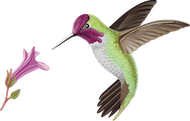The “Three P’s” of Native Plant Gardening
As a guideline for getting started with native plants, the California Native Plant Society offers the “Three P’s” of native plant gardening:
Plant Local
- Use plants that are as local as possible.
- While creating native landscapes can never replace natural habitats lost to development, planting gardens, parks and roadsides with California native plants can help provide an important bridge to nearby remaining wild areas. Many insects as well as animals depend upon native plants for food and shelter.
- Like all living things, native plants grow best under natural and familiar conditions, also known as biotic communities. Choosing plants that are native to your region will help ensure their optimum health and performance.
- Replace your conventional, water-thirsty non-native plants.
- Avoid using invasive plants.
Plant Light
- Group plants with similar water, sun and soil needs.
- Space your plants properly to allow them to grow to their genetic destiny, meaning their mature size in terms of height and width.
- Use water wisely.
- Wildlife will use your garden. If you must prune, schedule this for when it least impacts wildlife. This will also reduce green waste.
- Build healthy soils by allowing leaf litter to stay in place.
- Convert to organic gardening methods.
- Consider wind as a drying agent: if wind protection is added, where possible, less water is needed.
- Design your garden to use natural rainfall.
- Water during cooler hours of the day.
- Design and adjust your sprinkler system to only apply water as needed.
Plant Well
- Pair plants that grow together in nature such as in chaparral or oak woodlands—these are called “plant communities.”
- Create plant communities in your microclimates.
- Include plants that attract pollinators, including native bees, birds and butterflies, as well as other beneficial wildlife.
- Make your garden vegetation fire safe.
- Weave edible native and pollinator-friendly plants into your food garden.
- Enjoy the garden, embrace where you live and share it with wildlife.
How to Create Your Own Backyard Wildlife Habitat
The Gottlieb Native Garden is a certified Backyard Wildlife Habitat, and yours can be, too. Any piece of land, patio, balcony or roof—of any size—is eligible for certification through the National Wildlife Federation if it meets a set of criteria. Of course, you can reap the benefits of a wildlife habitat even if you’re not interested in obtaining certification.

Good backyard wildlife habitats must:
Provide food
At the Gottlieb Native Garden, hummingbirds buzz around hanging feeders, while other birds and insects feed on the hundreds of native plant species placed there to provide sustenance. To become certified, a garden must provide food for wildlife: ideally, a combination of plants indigenous to that area and hanging feeders to supplement the natural food sources.
Supply water
It’s critical to have a water source for wildlife to drink and bathe in, and there are many natural or man-made options: ponds, lakes, rivers, springs, oceans and wetlands, and birdbaths, puddling areas, installed ponds, or rain gardens. Especially in California, as frequent drought conditions threaten natural water sources, maintaining consistently clean water is more important than ever. The easiest way to meet this need is to install a birdbath — but be sure to change the water two to three times a week during warmer months. Best to install a pump to keep the water moving and avoid mosquito infestation and algae growth.
Create cover
The wildlife your property attracts will need some sort of shelter to hide from people, predators and bad weather. Shrubs, thickets and brush piles are great options; even dead trees work for some species. Man-made hideouts such as bird, bat and bee houses provide ample cover for the birds and pollinators you’ll want to attract.
Give wildlife a place to raise their young
Creating a wildlife habitat in your backyard is about creating a place for the entire lifecycle of a species to occur, from tadpole to frog, from caterpillar to butterfly. For the young to survive to adulthood, wildlife need places to birth and raise their young, protected from predators, weather and human beings. Some of the plants and structures that provide cover can also provide places to raise offspring, but at least two of the following must be present: mature trees, meadows or prairies, nesting boxes, wetlands, caves, host plants for caterpillars, dead trees or snags, dense shrubs or thickets, water gardens or ponds, or burrows.
Help wildlife thrive with healthy habitat
All wildlife depend on healthy, functioning ecosystems to survive. If you meet the above four requirements, but don’t garden in an environmentally friendly way, you are supporting the more specific needs of wildlife without fulfilling the most basic ones. Including native landscaping and using sustainable gardening practices are the final criteria for a backyard wildlife habitat. Mulch is a material (decaying leaves, bark or compost) that a gardener spreads around a plant to enrich or insulate the soil; by keeping water in the soil for the plant’s use, it reduces evaporation and cuts down on water consumption. Replacing grassy lawns with native and/or drought-tolerant wildflowers, ground cover, bushes, and trees minimizes the need for maintenance, watering, and chemical inputs including pesticides. Finally, removing invasive species to restore the healthy relationship between coevolved pollinators and plants helps wildlife and plants thrive.
Certification requires garden design that serves wildlife needs. Some call this type of gardening “ecosystem gardening,” for the emphasis it places on supporting the living things within a functioning ecosystem.
We can all make a real difference by restoring native habitat...
One yard at a time.

